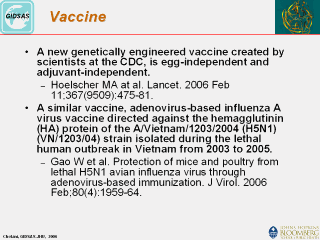 |
This CDC developed vaccine is a
replication-incompetent, human adenoviral-vector-based, haemagglutinin
subtype 5 influenza vaccine (HAd-H5HA), which induces both humoral and
cell-mediated immune responses against avian H5N1 influenza viruses isolated
from people. Their findings highlight the potential of an Ad-vector-based
delivery system, which is both egg-independent and adjuvant-independent and
offers stockpiling options for the development of a pandemic influenza
vaccine.
Gao et al showed in their study that mice vaccinated with full-length HA
were fully protected from challenge with VN/1203/04. They next evaluated the
efficacy of adenovirus-based vaccination in domestic chickens, given the
critical role of fowl species in the spread of HPAI worldwide. A single
subcutaneous immunization completely protected chickens from an intranasal
challenge 21 days later with VN/1203/04, which proved lethal to all
control-vaccinated chickens within 2 days. These data indicate that the
rapid production and subsequent administration of recombinant
adenovirus-based vaccines to both birds and high-risk individuals in the
face of an outbreak may serve to control the pandemic spread of lethal avian
influenza.
|
